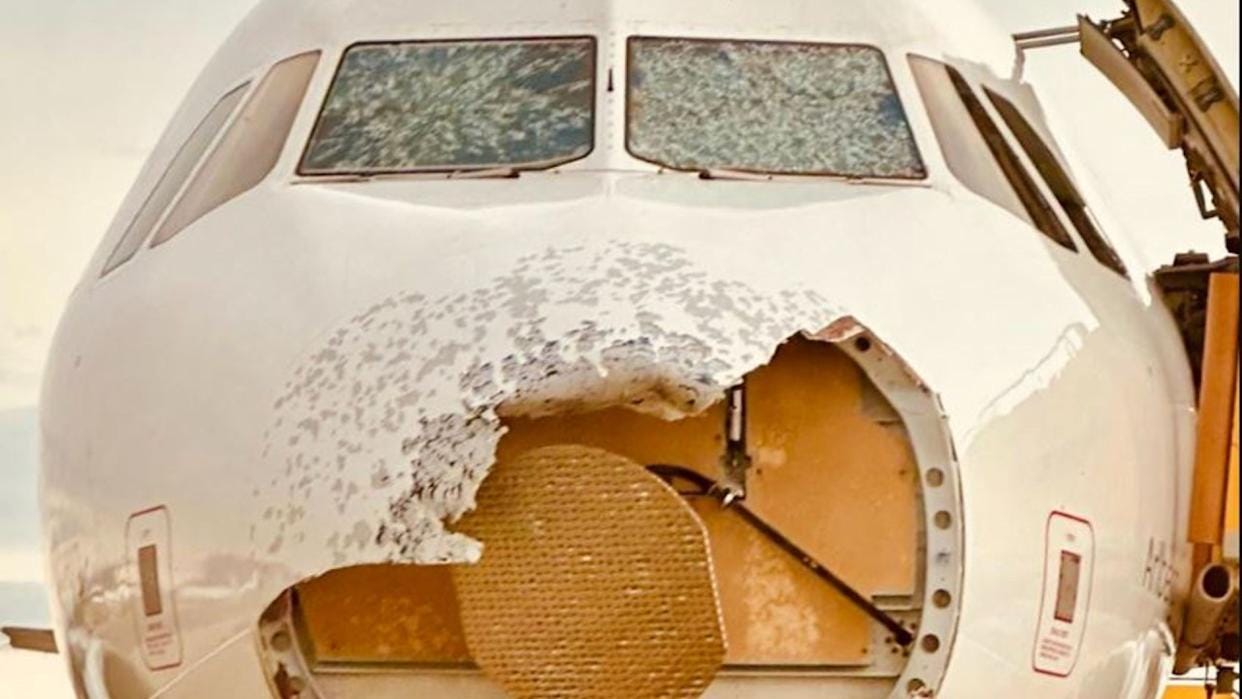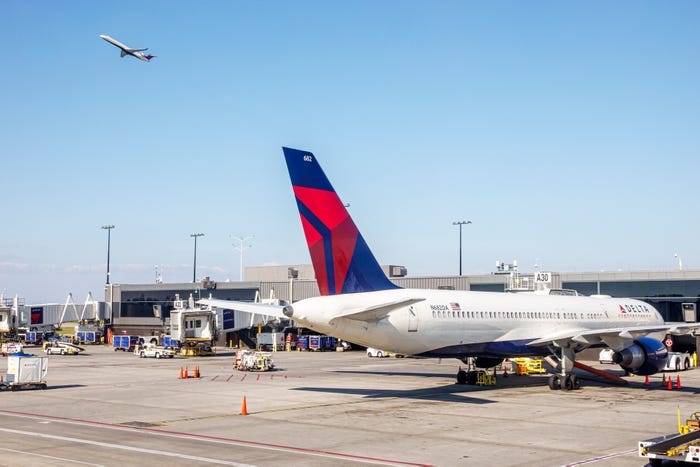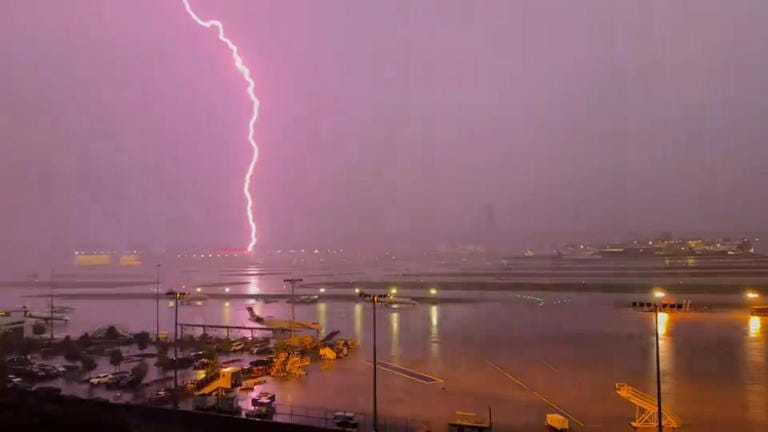Atlanta’s Hartsfield–Jackson International Airport, one of the world’s busiest aviation hubs, was brought to an abrupt halt Friday evening as powerful thunderstorms swept through the metro area, unleashing quarter-inch hail, torrential rain, and damaging winds that triggered a full-blown operational crisis.
I just happened to be there to witness it. Every summer, I put my daughter on a plane to New York to visit family. This time, her trip lined up with a powerful storm. As I drove to the airport, I could sense something was building. The sky had that eerie look it gets before a tornado warning—thick, swirling clouds and a strange grey-green hue that didn’t feel natural. It was heavy, electric, and ominous. You could feel the atmosphere shifting, like the weather was holding its breath before unleashing something serious.
Fury Unleashed
Shortly after arriving at the gate to wait for boarding, my daughter and I gave each other the side-eye as we heard the rumble of thunder and the downpour of rain. The sky lit up with bright lightning bolts. Then we hear the hail pelting the windows and the ground. You could barely see outside.
Although we didn’t know this happened in real-time, shortly before 7:00 p.m. on June 27, the Federal Aviation Administration (FAA) issued a full ground stop for all incoming and outgoing flights at ATL, citing extreme weather conditions that posed significant safety risks to both aircraft and airport personnel.
That was an understatement.
Just minutes later, conditions grew so volatile that the airport’s air traffic control tower was partially evacuated, with only a skeleton crew of controllers staying behind to maintain essential operations. We also did not find out about this until we started seeing news alerts on our phones.
Flash flood warnings had already been issued across Atlanta, and radar indicated strong microbursts moving through the area, wind phenomena capable of pushing planes off runways and damaging airport infrastructure.
This is a video I took to show my sister, who was going to pick up my daughter in New York, that the flight was likely not going to happen on Friday. She was convinced it would just be delayed.
Widespread Disruption
The impact was immediate and massive. By the end of the night:
Nearly 400 flights were canceled, and over 900 flights were delayed.
Delta Air Lines, which operates a major hub out of ATL, reported more than 90 diversions and began inspecting over 100 aircraft for possible hail damage.
Some flights were rerouted as far as Detroit, Orlando, and even Newark, as Atlanta’s airspace became temporarily unmanageable.
Terrible Timing
The storm’s timing couldn’t have been worse. Not just for me, but it's a big travel week for the July 4th holiday. The disruptions left thousands of passengers stranded or scrambling to rebook their flights. Hotel availability and rental cars near the airport quickly dwindled as travelers sought overnight lodging, while others spent hours waiting inside crowded terminals. Many just found a spot to lie down and get some rest.
I was lucky. I don’t live in Atlanta, but I’d take a 1.5-hour drive back home rather than sleeping in the airport any day of the week. I rebooked the flight for Saturday (the next day) and made my way back home. My daughter and I would try again later.
Bad to Worse: Delta Grounds Aircraft
One reason why I decided to call it a night and go home was that Delta temporarily grounded over 100 aircraft that had been on the tarmac during the hailstorm. Each plane had to be meticulously inspected for damage, particularly to windows, wings, and control surfaces.
I saw the hailstones. They were golf ball-sized at one point of the storm. I’m shocked that planes didn’t sustain significant damage. Fifteen years ago, I saw my sister’s smashed windshield from a hailstorm in New York. If you have never seen the results of a nasty hailstorm, hail can do some severe damage, and it only takes one tiny puncture in the cabin to go unnoticed for something terrible to happen mid-flight.
While most of the fleet was cleared to fly again by Saturday morning, the ripple effects from the delay continued to cascade through weekend flight schedules.
The situation at ATL was slightly better when I returned, but it was just as chaotic, and my daughter’s flight was delayed by four hours. I spoke with people who had been at the airport for well over 24 hours. A couple was stuck on the runway for five hours before they could return to the gate, allowing the plane to be inspected for hail damage.
By Sunday, Delta had canceled close to 500 flights in total, making this one of the most disruptive non-hurricane weather events the airline has faced in years.
The Intel
While I was rebooking the flight on Friday night, I started talking with the Delta representative. She confirmed that our flight was unlikely to take off tonight. I asked her how long it would take for everything to catch up. She said it would take days for everything to return to normal. Then she told me about inspecting the planes.
Inspections after a hailstorm are not optional; federal regulations require them. They have to do them. She was frustrated by people who were upset that they had to wait for the planes to be inspected and who took their frustration out on her, which seemed wild to me because, as I mentioned earlier, I had seen what hail could do to vehicles. I would not want to be in an airplane thirty thousand feet in the air with a puncture that went unnoticed.
While some just wanted to leave and get in the air, I was in the camp of doing what needed to be done to make sure ice stones didn’t puncture anything that would cause the plane to fall out of the sky. While I was tired and cranky, there was no point in getting worked up. It is what it is, and no company can control the weather.
Maybe I’m the weird one, but I’ll take caution over convenience whenever it comes to air travel.

We Already Forgot About the East Palestine, OH Derailment
On February 3, 2023, a Norfolk Southern freight train derailed in East Palestine, Ohio, just south of the Pennsylvania border. The train had 149 cars, 20 of which carried hazardous chemicals, including vinyl chloride, benzene, butyl acrylate, and isobutylene. Thirty-eight cars left the tracks, including 11 tankers filled with toxic materials.
In 2015, the Obama administration implemented a regulation requiring high-hazard trains to be equipped with electronically controlled pneumatic brakes. This modern system can stop long trains more quickly and evenly than the outdated air brakes still used by most freight trains.
But in 2018, under pressure from the rail industry, the Trump administration repealed that rule. The Department of Transportation claimed the cost didn’t justify the safety benefits, even though these brakes might have prevented or reduced the severity of this derailment.
The result was an environmental crisis. Authorities evacuated residents within a one-mile radius. A massive chemical plume killed tens of thousands of fish and other aquatic life. People reported rashes, difficulty breathing, burning eyes, and other symptoms after the release.
The NTSB later determined the derailment was entirely preventable. Investigators pointed directly to Norfolk Southern’s refusal to invest in safer technology as a key factor.
Side note: This story is worth revisiting. It is a textbook case of what happens when corporate lobbying weakens safety regulations. The public pays the price while the companies responsible face little real accountability.
Corporations Need Some Regulation
Federal regulations can feel frustrating and inconvenient to the general public. For corporations, they’re even more unwelcome, mainly because they often come with a price tag. While regulations can create bureaucracy and sometimes need to be revised or repealed for good reason, the truth is, we need them. They exist to protect people, not profits.
I want to believe that Delta Air Lines prioritizes passenger safety, and they wouldn’t skimp on safety protocols. Still, I’m not convinced they would if there were no regulations governing them. At the end of the day, they are a corporation, and like most corporations, their primary focus is the bottom line and keeping shareholders happy. We have seen it again and again. Companies cut corners on safety protocols to protect profits.
Look at the pattern. How many train derailments have led to chemical spills that harm people and the environment, all because companies did not want to invest in better braking systems? The cost of safety is weighed against revenue, and too often, safety loses out.
I have no reason to think Delta would be any different.
DOGE
Between Trump’s casual disregard for safety regulations and the DOGE slashing essential oversight, it’s hard not to feel uneasy about how exposed the American public is to a transportation disaster. Most corporations won’t voluntarily put public safety above their profits. Some systems require third-party governance, and airplane safety should remain under strong government regulation.
When profit drives decision-making and oversight is stripped away, public safety becomes an afterthought. We’ve seen what happens when corporations are left to regulate themselves, corners get cut, warnings are ignored, and people pay the price. Government regulations may not be perfect, but they exist for a reason. In critical areas like transportation safety, they're not just necessary; they’re non-negotiable.





